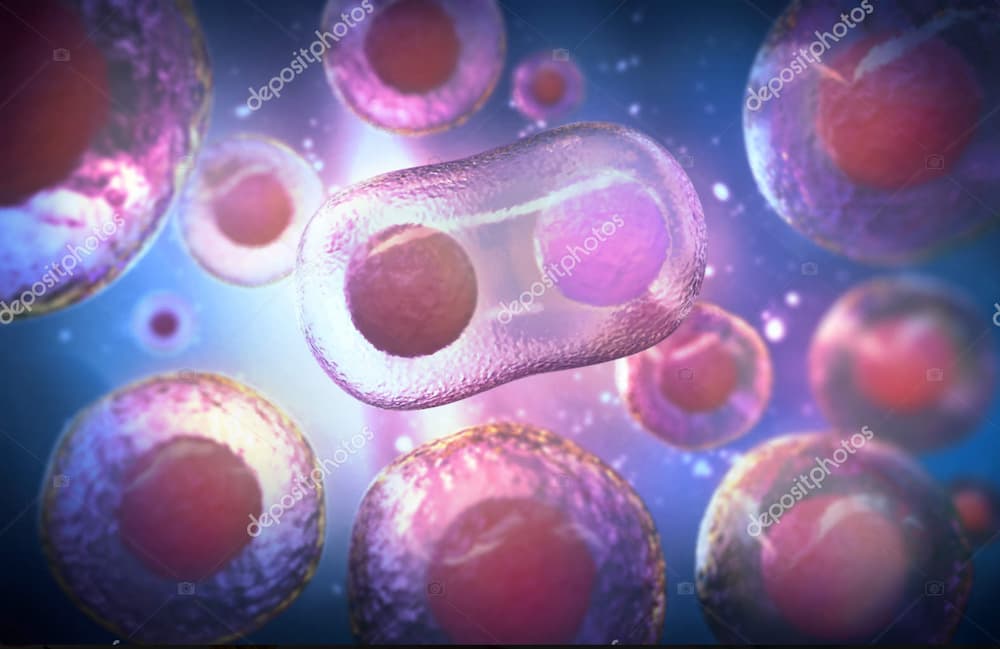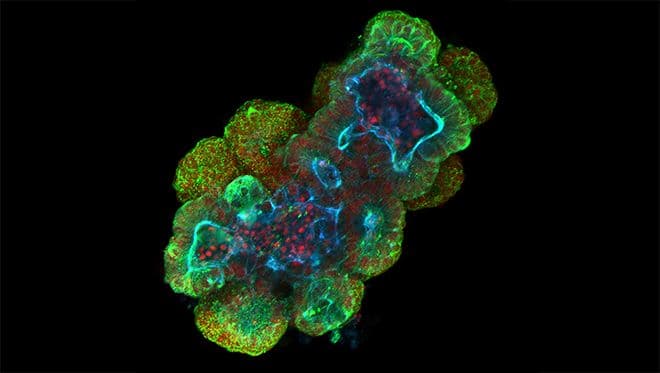Stem cells have received significant attention in the medical and scientific media in recent years. However, a general understanding of this topic is often fragmented, with information sometimes gathered from unreliable sources. If you still find stem cells confusing, this article is for you. Here, we will try to answer these questions:
- What are stem cells?
- Where do stem cells come from?
- What are stem cells used for?
What Are Stem Cells?
A stem cell is the raw material from which all other cells in a body are created. These cells have the unique ability to develop into various specialized cell types. In a way, a stem cell is like a newborn child that can grow up and acquire any profession under the right circumstances.

What Does a Stem Cell Look Like?
Stem cells typically have a small, round, or elongated (spindle-shaped) body. They have a large nucleus, which is the central part of the cell, and the nucleus has very visible inner structures called nucleoli.

The exact shape and appearance of stem cells can vary depending on the specific type of stem cell and how developed or differentiated the cell is. For example, less mature stem cells may look different than stem cells that have started to transform into a particular cell type.
Closely examining the physical appearance of stem cells is an important way for scientists to evaluate the quality of the stem cells. That’s how they determine whether the cells are still in an undifferentiated, unspecialized state.
Understanding Stem Cells: Exploring Their Role in Medicine and Research
This unique ability makes stem cell studies a prominent area of research. There are 3 main ways in which understanding stem cells is beneficial:
- Observing stem cells tells us how diseases develop.
Studying the process by which stem cells differentiate (i.e., become functionally specialized cells) allows researchers to gain insights about the way some conditions affect living tissues. This deepens our knowledge of how human bodies work. - Stem cells can be used for treatment.
What is stem cells’ most well-known application? Arguably, it is their regenerative medicine potential. Different types of stem cells help with various health issues, but all of them make use of stem cells’ ability to create specific living cells. Stem cell therapy is often employed when traditional methods can neither alleviate the symptoms nor slow down the disease. - Stem cells assist in drug development
Before introducing human tests, researchers can create controlled and safe environments in which they monitor drug effects and toxicity on living tissue without any danger to test subjects. Furthermore, stem cells allow the simulation of specific, narrow cases that merit researchers’ attention.
Get a free online consultation
Please, contact our medical advisor to discuss your health condition with a specialist in regenerative medicine. You can also leave your contact details for a callback. It is free and confidential.

MD, Endocrinologist, Pediatrician, regenerative medicine specialist, R&D director
Definition of Stem Cells
So, what are stem cells, exactly? Now that we have a broad notion, we can get into specifics.
Types of Stem Cells: Embryonic and Adult
One of the characteristics that allows classifying cells is their division into embryonic and adult. One of the most frequently discussed questions is what types of stem cells should be used in therapy. However, these stem cell examples are different not only in their origin but also in their characteristics and application.
- Embryonic stem cells are taken from the embryos in the early stages of development. These cells are called ‘pluripotent’ which means that they can become any other specialized cells that are found in the human body. As the use of these cells involves the destruction of human embryos, it is considered morally unacceptable by many people.
- Adult stem cells, specifically mesenchymal stem cells (or MSC), are usually sourced from donor umbilical cords or placentas. They are found in differentiated tissues and can be cultivated into a variety of functional cells. While they have a more limited differentiation potential compared to embryonic stem cells, they can stop damaging processes and restore other cells, tissues, and organs.
At Swiss Medica, we use only MSCs because of their specific properties that make them the safest option for stem cell therapy.
Characteristics and Properties
These are the fundamental properties shared by all types of stem cells:
- Self-renewal. Stem cells can replicate themselves, a process sometimes not achievable by some of the human cells in muscle, nerve, and blood.
- Tissue creation. Stem cells create tissue-specific cells through differentiation. For example, a blood cell’s lifespan is about 120 days. Stem cells, particularly those in the bone marrow, play a crucial role in replenishing blood cells as well as regeneration and repair of other tissues, such as muscle, nerve, and organ tissues. That’s why they are vitally important.
But when we address the application of stem cells, there are several advantages to MSCs specifically.
- Easy to collect and maintain. Adult cells are more accessible and abundant, which makes them more practical.
- Ethically straightforward. Harvesting cells from embryos is a controversial topic from an ethical point of view. This doesn’t apply to the MSC collection.
- Immune-privileged. MSCs (even if taken from another person) have been shown to have immunosuppressive properties and can evade certain aspects of the immune response.
Importance of Stem Cell Studies
Stem cells possess a variety of beneficial properties, which is why they find extensive applications in medicine and biology. What are stem cells used for?
Medical Applications and Treatments
Stem cell studies are an area of research that has already produced tangible benefits in the form of different types of cell therapy. These therapies have shown promising results in treating neurological and autoimmune disorders, musculoskeletal injuries, metabolic syndrome, skin diseases, and other conditions related to the damage of tissues or cells.
It should not be viewed as a panacea, however. For more severe afflictions, cell therapy might not provide a definitive cure. What do stem cells do instead? They offer a way to alleviate the symptoms, heighten the quality of life, and halt disease development.
Breakthroughs in Disease Research
There have been some breakthroughs in our understanding of certain diseases, largely due to cell stem studies. As a result, researchers now have new tools at their disposal, which create opportunities that were previously unavailable.
One such tool is organoids, which are 3D miniature versions of living organs created in a lab. They closely resemble real organs in how they work, which allows researchers to conduct experiments that would be impossible otherwise, model difficult processes, and derive insights from them.

Potential for Regenerative Medicine
Stem cells have the potential to cure some conditions that were previously untreatable, such as spinal cord injury-induced paralysis. Research in stem cells encompasses diverse areas, including experiments with insulin-secreting cells, genome editing, and numerous other research avenues. The regenerative capacity of stem cells offers hope for addressing many debilitating conditions that threaten human health.
Contact us
Get a free online consultation to learn about the expected results of stem cell therapy for your case, what is the cost of the treatment, and its duration.

MD, Endocrinologist, Pediatrician, regenerative medicine specialist, R&D director
List of References
Zomer HD, Vidane AS, Gonçalves NN, Ambrósio CE. Mesenchymal and induced pluripotent stem cells: general insights and clinical perspectives. Stem Cells Cloning. 2015 Sep 28;8:125-34. doi: 10.2147/SCCAA.S88036. PMID: 26451119; PMCID: PMC4592031.https://pubmed.ncbi.nlm.nih.gov/26451119/
Rubin LL, Haston KM. Stem cell biology and drug discovery. BMC Biol. 2011 Jun 7;9:42. doi: 10.1186/1741-7007-9-42. PMID: 21649940; PMCID: PMC3110139. https://www.ncbi.nlm.nih.gov/pmc/articles/PMC3110139/
Kumar D, Baligar P, Srivastav R, Narad P, Raj S, Tandon C, Tandon S. Stem Cell Based Preclinical Drug Development and Toxicity Prediction. Curr Pharm Des. 2021;27(19):2237-2251. doi: 10.2174/1381612826666201019104712. PMID: 33076801. https://pubmed.ncbi.nlm.nih.gov/33076801/
Kolios G, Moodley Y. Introduction to stem cells and regenerative medicine. Respiration. 2013;85(1):3-10. doi: 10.1159/000345615. Epub 2012 Dec 13. PMID: 23257690.https://karger.com/res/article/85/1/3/290661/Introduction-to-Stem-Cells-and-Regenerative
Thiagarajan P, Parker CJ, Prchal JT. How Do Red Blood Cells Die? Front Physiol. 2021 Mar 15;12:655393. doi: 10.3389/fphys.2021.655393. PMID: 33790808; PMCID: PMC8006275. https://pubmed.ncbi.nlm.nih.gov/33790808/
Tang XY, Wu S, Wang D, Chu C, Hong Y, Tao M, Hu H, Xu M, Guo X, Liu Y. Human organoids in basic research and clinical applications. Signal Transduct Target Ther. 2022 May 24;7(1):168. doi: 10.1038/s41392-022-01024-9. PMID: 35610212; PMCID: PMC9127490.







